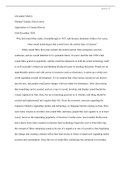Morley 1
Alexander Morley
Michael Temple, Eleni Liarou
Approaches to Cinema History
10th December 2020
Why did sound films make a breakthrough in 1927, and become dominant within a few years,
when sound technologies had existed since the earliest days of cinema?
When sound films first came around, the initial reaction from consumers was fear,
confusion, and an overall disbelief in it’s potential future. It wasn’t until the late 1920’s that
sound films gained in popularity, and the small developments in both the actual technology itself
as well as people’s behaviour and thinking all played a part in reaching that point. People are an
unpredictable species and with access to resources such as electronics, it opens up a whole new
world regarding societal development. It’s no surprise that when money and power are thrown
into the mix, that people would grow hungry with new plans for dominance. After discovering
that something can be created, such as a way to record, develop, and display sound beside the
visuals captured on film, there lies an overarching question as to whether said thing should be
created and implemented into regular daily life. From the economic concerns regarding the
expenses related to upgrading studios and technology, to language barriers raising worries, there
were many reasons to not delve into sound film, and many people that were against it, or at least
weary; however the impending popularity of America’s media scene, most notably Hollywood,
and a desire from other countries to harness their technology began the swerve from believing
the concept of films containing sound to be one of a negative to one of a positive, thus beginning
the change and creating a domino effect that lead society to where it stands now regarding media
creation and consumption. Since the rise of sound film, technology has advanced even further,
, Morley 2
and is now a crucial part of cinema as evident by the emphasis of sound design and well written
dialogue. It adds another layer of realism, and ultimately another layer of storytelling that
previously wasn’t there, which has shaped the world of film and cinema a lot into what we know
today. If you asked people today whether they’d prefer to watch a silent film or a sound film,
most would say sound. Just like in the 1920’s though, people like what they’re used to. So, while
people today are used to sound film, those back then were not, hence the fear and apprehension
from consumers. After enough time, that changed though.
Since Edison’s invention of the phonograph in 1877, the first device that could capture
and playback audio, sound recording technology has greatly improved. These technologies
served many purposes, from capturing music, to capturing the voices of those to be heard once
deceased; but in addition to these technological feats, many were experimenting with the idea of
putting sound to images, thus replicating what is experienced as human beings to the best of their
abilities. Originally the phonograph that Edison had created was to be connected to a film
projector, but an alternative option was to figure out a way to directly record the sound onto the
film. The latter method ended up being in use throughout the 1930’s and considered the standard.
(Christie, 2001, pp. 211) When sound started being implemented into film, it wasn’t originally
used for dialogue, Instead, many films contained minimal dialogue and instead focused on
musical scenes as this was seen as an easier transition. As said in Sight and Sound by Mulvey,
“For the Warner’s, synchronised sound did not mean the talkies; it simply meant the addition of
song and music to motion picture” (1999, pp. 18). These movies were essentially silent films
aside from a few inserts and musical numbers, which made sense considering silent movies were
never viewed in silence. Rather, there would be live music being played in the theatre, utilised to
set the tone, as well include sound effects. When the film The Jazz Singer (1927, Alan Crosland,




